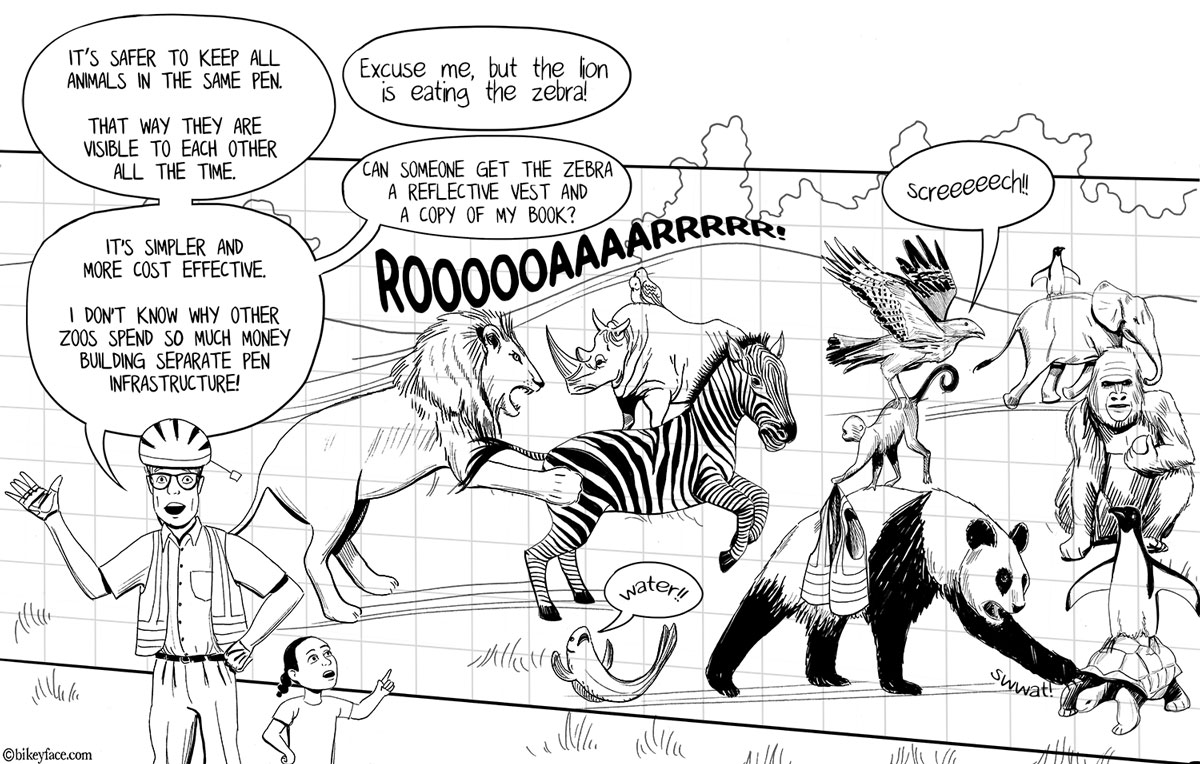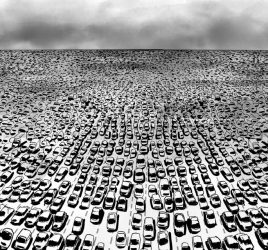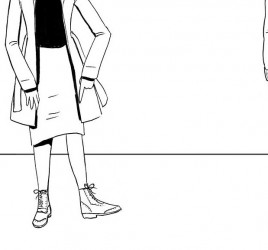
A Zoo
I have to bicycle vehicularly most of the time because there’s not much infrastructure yet. But I’d prefer not to. What I can’t understand why anyone would argue against protected bike lanes.
I wonder how the argument would go if applied to other things- like a zoo?





Reading my own and some other comments I wonder if some of us my be using the same term to describe different things, or different terms to describe the same things.
The definitions I have in my head when I use the terms are
Bike path, also called a MUP or multi user path. An off road, improved surface path. These are similar to sidewalks but generally wider and paved with asphalt instead of concrete. Used mostly by cyclists but open to but not limited to the following users. Dog-walkers, pedestrians, joggers, skate boarders, roller bladers, and wheel chairs Basically, most non-motorized traffic can use them.
Bike Lane An on road lane, striped and dedicated to bicycles only.
Segregated Facility An off road improved surface path, physically separated from the road and dedicated to bicycles only.
“Reading my own and some other comments I wonder if some of us my be using the same term to describe different things, or different terms to describe the same things.”
If it’s of any help, the definitions now used as more-or-less standard in the UK are:
– Cycle lane: a painted-on strip down the side of a road for the use of pedal cycles (and sometimes buses as well), but not physically separated form the vehicle carriageway.
– Cycle track: a part of a road designated solely for the use of pedal cycles, and physically divided from the vehicle carriageway by a concrete berm, a kerb, bollards, a steel fence or some other physical barrier preventing motor vehicles from encroaching upon it
– Cycle path: a road dedicated specifically and solely to pedal cycles (plus pedestrians, roller bladers etc.), and not associated with any motor-vehicle carriageway running parallel to it.
Most Dutch segregated infrastructure would therefore be defined as cycle tracks, though the country also has an extensive network of cycle paths running across country, plus a lot of cycle lanes painted down the sides of suburban back streets and quiet country roads. The often highly dangerous British half-solution of painting cycle lanes on busy major roads (…so that they can be used as parking space, thus forcing cyclists even further out into the traffic if they want to stay out of car-door range) is unknown in the Netherlands.
Elias: “or at least personal stories that have some basis”
OK, I am a driver of motorized vehicles (small car, small truck, 26’/8M delivery truck), as well as being that rarest of animals, the “surviving” vehicular cyclist.
Observations: In the last week, while driving, I have narrowly avoided fifteen or more crashes with bicyclists who were ignoring traffic laws. These include folks who seemed to be locals on their way to or from work, recreational cyclists and tourists (on BikeShare steeds). This is a typical week. The hazards I’m exposed to by similar bicyclists are as common when I am riding my bicycle. Conclusion of observations: bicyclists ignoring traffic laws are at significant risk of crashing. Corollary: If you’re making claims about causation, your honesty is in question if you don’t get into the crash reports and read them, including the diagramming.
Anecdotes: I haven’t had a significant crash involving a car since 1986. I live in the fourth worst metro area in the US for cycling crashes and fatalities. I ride in the street in a boring and predictable manner, sharing lanes that are wide enough and assertively taking the space I need when I need to. I have friends who are club cyclists who ride locally who have had crashes – upon interviewing them, there are things they do (curb hugging, running stop signs, queue jumping, attempting to share narrow lanes) which have contributed to almost every crash I’ve been made aware of. These are hazardous behaviors with real-world consequences. Conclusion of anecdotes: In ca. 100,000 miles of cycling I have had one car-involved crash and a couple dozen close calls. Friends who ride less predictably have crashes and are often scared shitless. It’s better to be bored than scared.
For a good overview of how to safely do what I do visit http://cyclingsavvy.org/ and http://www.bikexprt.com/streetsmarts/index.htm
I could give you similar anecdotes about the behaviour of drivers while I’m cycling (or even just walking). So what? My anecdotes would match the official figures of course, while yours don’t, but even leaving that to one side…
The stats (and the Newtonian physics) are pretty clear – its the motorised vehicles that pose the risk and which kill people. The cars create the danger, its the cars and their users that need to be better regulated and kept away from those they pose a risk to. Its not complicated.
„It’s better to be bored than scared.“
True indeed:
Number of people killed per 100 million kilometers cycled US (poor cycling infrastructure, mostly vehicular cycling): 5.8
Number of people killed per 100 million kilometers cycled Netherlands (excellent cycling infrastructure, vehicular cycling unknown): 1.1
Number of people injured per 10 million kilometers cycled US (poor cycling infrastructure, mostly vehicular cycling): 37.5
Number of people injured per 10 million kilometers cycled Netherlands (excellent cycling infrastructure, vehicular cycling unknown): 1.4
Modal share bicycle US (poor cycling infrastructure, mostly vehicular cycling): 1%
Modal share bicycle (excellent cycling infrastructure, vehicular cycling unknown): 27%
The evidence is overwhelming: Good separate infrastructure makes cycling safe and does wonders to the modal share. But, as Vocus said: „But in one important respect humans aren’t like lions at all: they can talk and they can read and they can elaborate theories. And they have a fatal tendency to go on believing those theories despite overwhelming evidence to the contrary. “
For a good overview of how to make cycling safe and irresistible not just for you, but for everyone read: John Pucher, Ralph Buehler, 2008: Making Cycling Irresistible: Lessons from The Netherlands, Denmark and Germany. In: Transport Reviews 28 (4).
Wow, did you jump into a debate. Congrats.
I’ve often thought it would be cool to have John Forester to debate Mikael Colville-Andersen on this. Their views are diametrically opposed, they are both intelligent, and they both have facts to support their points of view. It would be edifying and entertaining.
My own belief is that for some reason bicycling tends to bring out extremes in belief. Perhaps it’s all that time riding, thinking about things. I think separated infrastructure is great for new riders, and for situations where there’s a lot of traffic competing for space. Vehicular cycling is an important technique to know and practice (and Forester’s book is really brilliant at explaining it) as the safest way to ride with cars. The two approaches aren’t exclusive, they are complementary.
Zebra is not wearing a helmet.